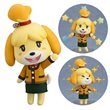It's All About Mii: Thoughts on Nintendo's Tomodachi Life and Miitopia
I've played so many kinds of video games over the years, from brief coin-op adventures in video game arcades to hours-long campaigns on home consoles. However, one particular kind of gaming never made sense to me: the "life simulator". The idea of creating and managing the day-to-day life of a set of characters (human or otherwise) never appealed to me as a form of entertainment. It seemed too boring: there were no impulsive thrills, no high scores to accumulate, and no unlockable rewards at the end of a story. I held this opinion before Nintendo exposed me to its iconic avatars, the Miis.
My experience with the Miis proved one of the most valuable lessons in promoting a new technology: If you want users to desire a product, it has to engage them both creatively and emotionally. Thus, what better way to accomplish this goal than by allowing users to put faces of their own design on the product? Read on ...
I first encountered the Miis when Nintendo introduced them through its Wii console. It was a cute concept: inserting yourself into video game adventures via a cartoonish surrogate. As such, the Miis were a key part of the Wii's launch titles such as Wii Play and Wii Sports, and they continued to appear in various other games throughout that console's lifecycle. In fact, Mii-centric titles frequently accompanied new Wii accessories, such as the Wii MotionPlus (Wii Sports Resort) and the Wii Balance Board (Wii Fit).
Not content to let gamers just play with their own Miis, Nintendo left the option open for gamers to make and use as many Miis as they wanted and then share the custom Miis with other Nintendo gamers. Such a creative outlet proved useful in the long run: Even though Wii and its immediate successor console (the Wii U) are no longer on store shelves, there are still customized Mii websites out there that players can use to add Mii characters to their current Nintendo systems.
The Mii Maker in action on the Wii U gaming console.
Miis were plenty of fun to play with on the Wii and Wii U, but I don't think that Nintendo utilized them to their fullest potential until the handheld 3DS system. Being a latecomer to the 3DS, I have since discovered the joys of Tomodachi Life, the Mii life simulator game, and its thematic sequel Miitopia. Both games are very goofy, low-key, and amazingly addictive.
In Tomodachi Life, players put Miis on an island (which players can name) and then care for the Miis by providing various resources (food, clothing, gifts, room decorations, etc.) while the Miis interact with each other. The goal of the game is to keep the Miis as happy as possible (which sometimes means cheering them up after some kind of disappointment) so they can "level up" to new heights of happiness.
A place for Mii: the island setting of Tomodachi Life.
Achieving the goal of Mii happiness is only one half of the game's entertainment value; the other half is just watching the Miis do cute, kooky and colorful things with each other at various places around the island (having fun at the amusement park, building sandcastles at the beach, chatting about daily activities at the coffee shop, singing songs at the local karaoke club, etc.). There's also a news channel that regularly runs ridiculous stories involving the Miis.
I don't know enough about the life simulator genre of video gaming to determine how Tomodachi Life compares to other games of this type. Then again, I don't think that such a comparison is relevant in order to appreciate this game. Tomodachi Life may employ many of the conventions that are known within the genre, but its overarching goal is to keep players engaged with their Mii creations and to keep using them with Nintendo products. If players wind up playing other life simulator games because of Tomodachi Life, that's great--but that's not the point. For me, watching Miis that I created take on odd, unpredictable lives of their own has been entertaining enough that I want to keep coming back for more to see what they do next.
A Mii marriage in the making in Tomodachi Life.
As the follow-up to Tomodachi Life, Miitopia is to fantasy role-playing games (RPGs) is what its predecessor is to life simulator games; inevitably, the fantasy plot of Miitopia is just as wacky as the antics of Tomodachi Life. Players can choose between standard fantasy RPG roles such as warrior, mage and thief, or they can choose something more unconventional such as scientist, pop star, or flower. The array of monsters that players will fight also range from the standard RPG types (dragons, ogres, griffins) to the not-so-standard (combative tadpoles, possessed paintings, angry hamburgers).
What Miitopia also carries over from Tomodachi Life is the importance of building relationships: As more characters are added, they build friendships with each other that improve overall team performance during attacks as the game progresses. Building team skills during a quest is part of the RPG experience, but keeping the Miis social with each other and building their friendships adds considerably to Miitopia's daffy charm.
What kind of Mii will you be in Miitopia?
In Miitopia, players have the options of creating new Miis from scratch, importing Miis from online, or using Miis that were already created using Mii Maker or Tomodachi Life. Prior to Miitopia, the only RPG video games I played were those where I could play in real time with other players. To compensate for the lack of other players, I cast many of my Tomodachi Life Miis as Miitopia characters; it feels like I'm playing a lighter, fluffier Dungeons and Dragons with a group of prefab friends.
How one feels about the Miis will definitely impact whether how much one likes Tomodachi Life and Miitopia. I know that there are those who absolutely despise the Miis: Between the failure of the Nintendo smartphone app Miitomo, the discontinuation of the Miiverse social network, and the diminished representation of Miis on the current Switch console, some have gleefully predicted that the end of the Miis is at hand. If that is indeed the case, then at least I got what I wanted out of them: a chance to engage in forms of game play that I never would have thought about before. Thanks to the 3DS Mii titles, I'll probably pick up Animal Crossing: New Leaf and Ever Oasis sometime in the future, games I never would have considered otherwise.
I hope that Nintendo will keep the Miis going for foreseeable future. Their approachability and ease of use make them ideal for introducing new gaming hardware and software, and their customization give players a sense of emotional connection and creative investment that other forms of branding doesn't provide. Ultimately, I think that Miis did for Nintendo's recent consoles what imaginative graphic art did for the Atari 2600 way back in the '70s and early ‘80s: They draw consumers to new ways of thinking about and playing with technology that might otherwise baffle or intimidate them.
Related Products:











Comments
Post a Comment